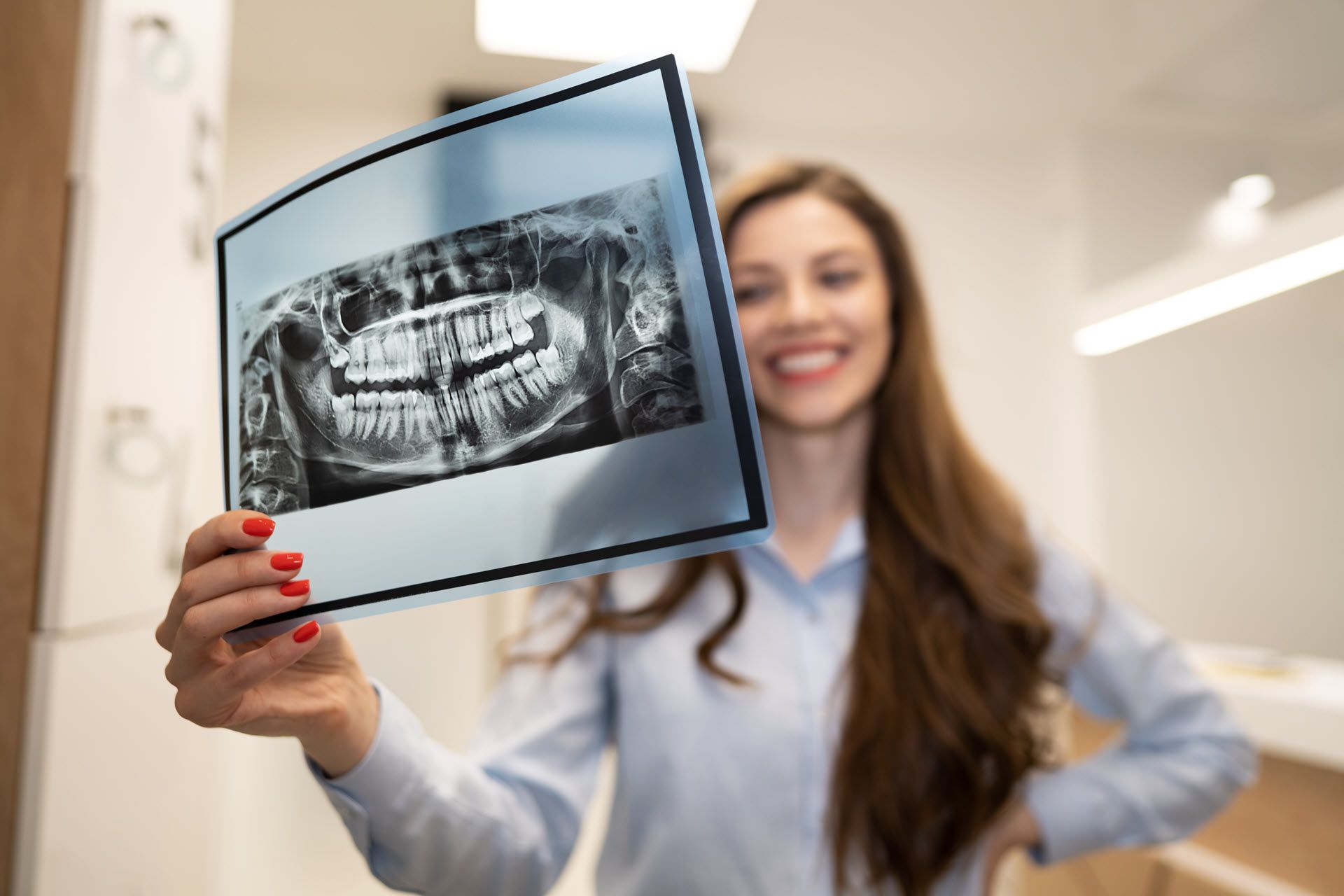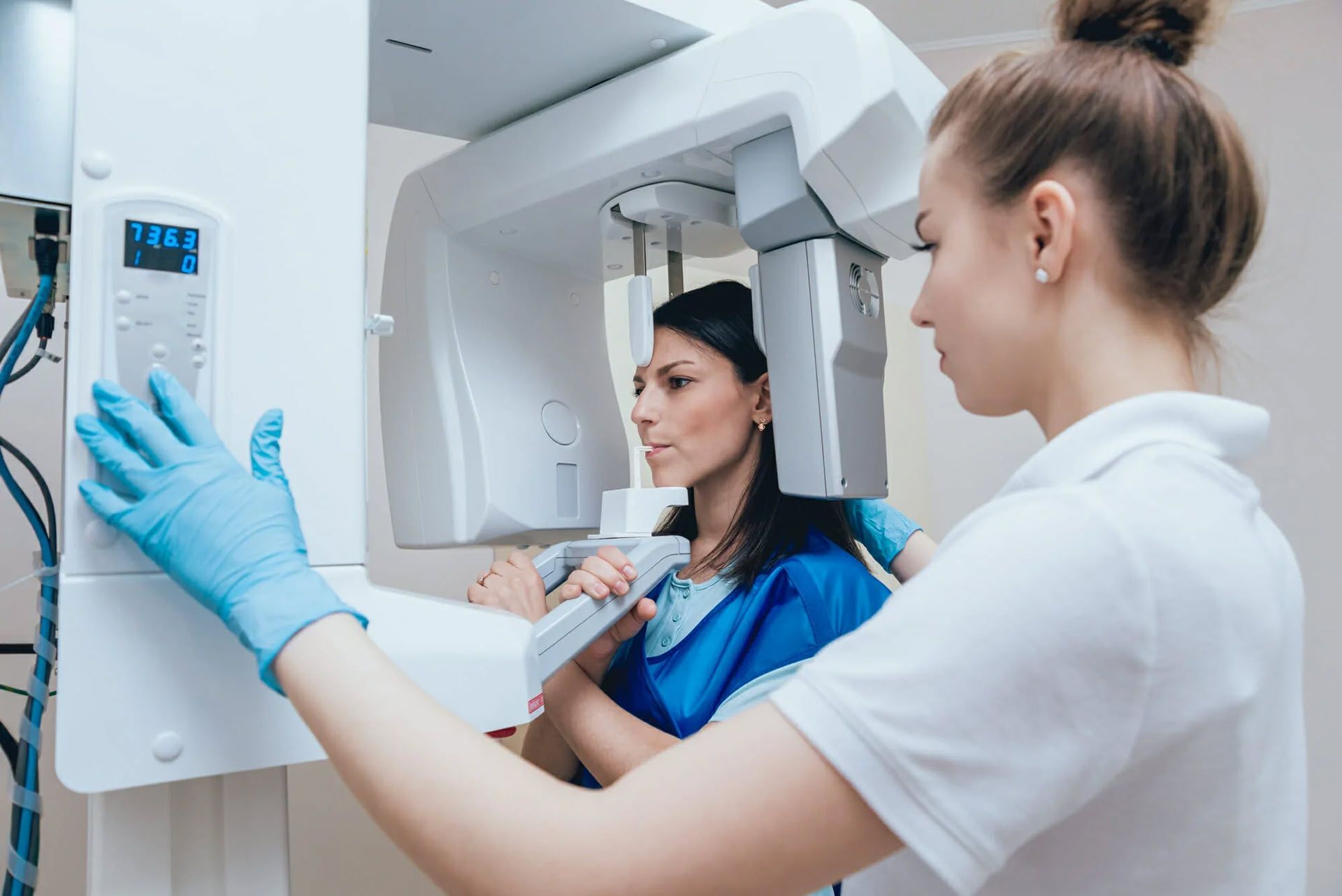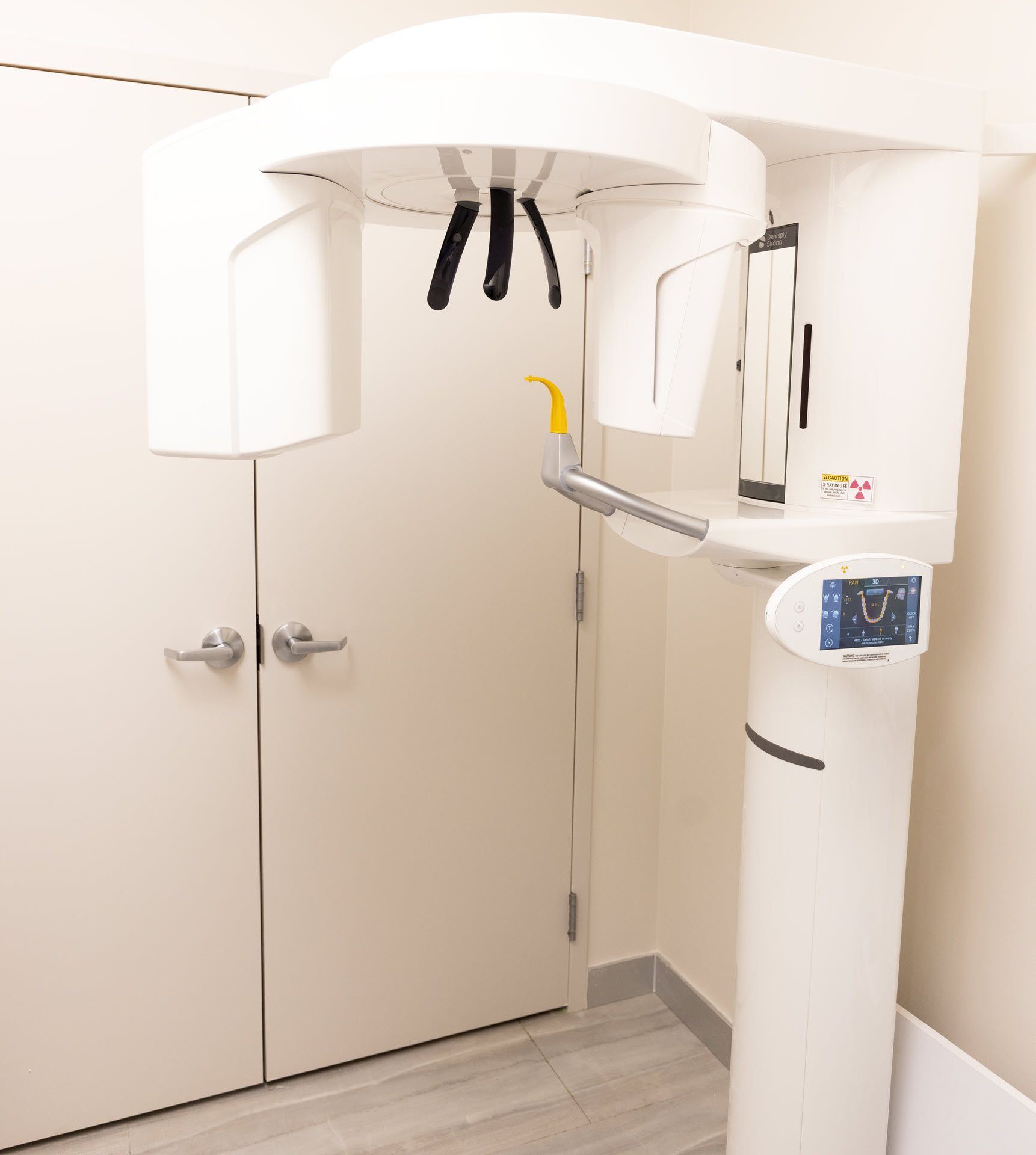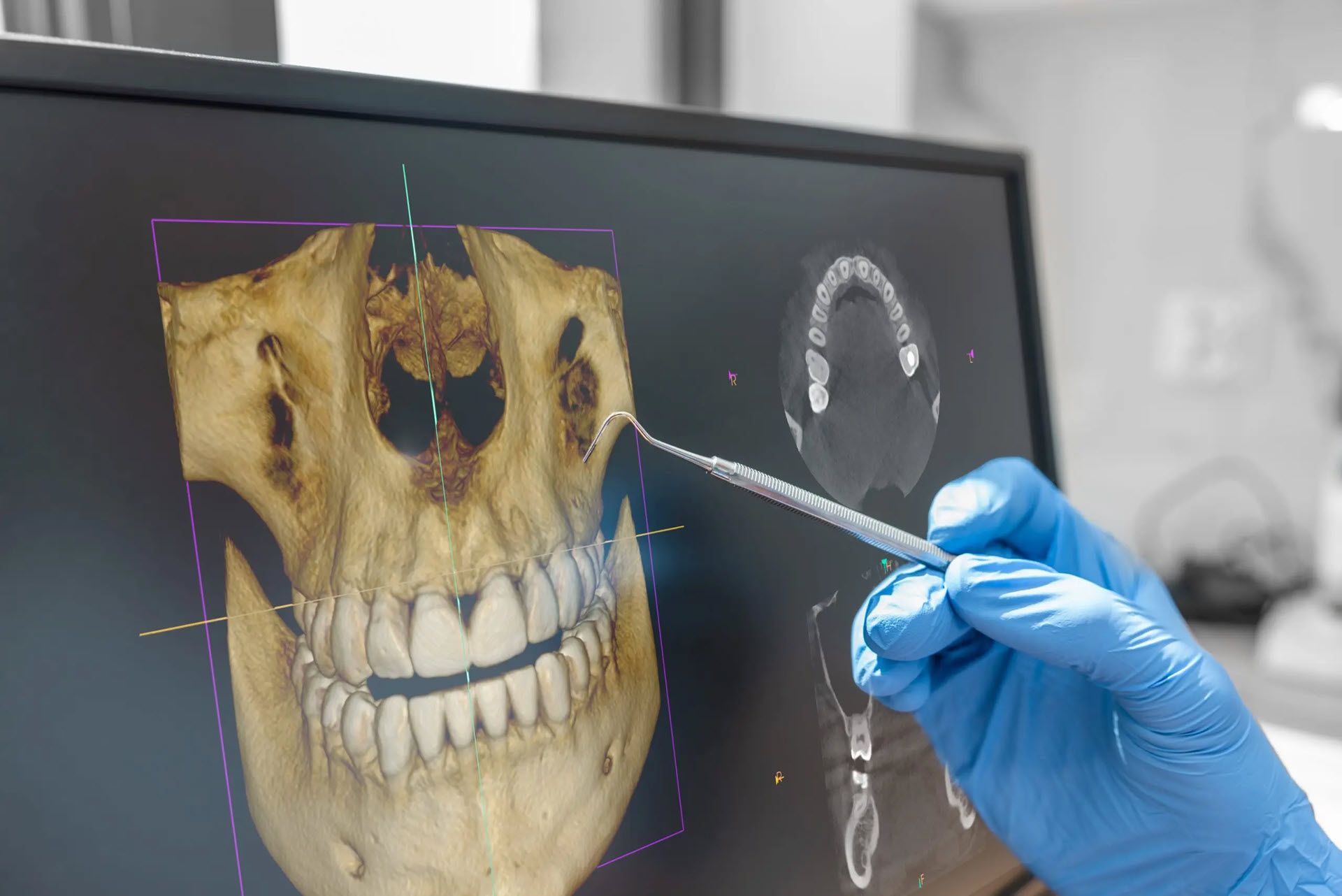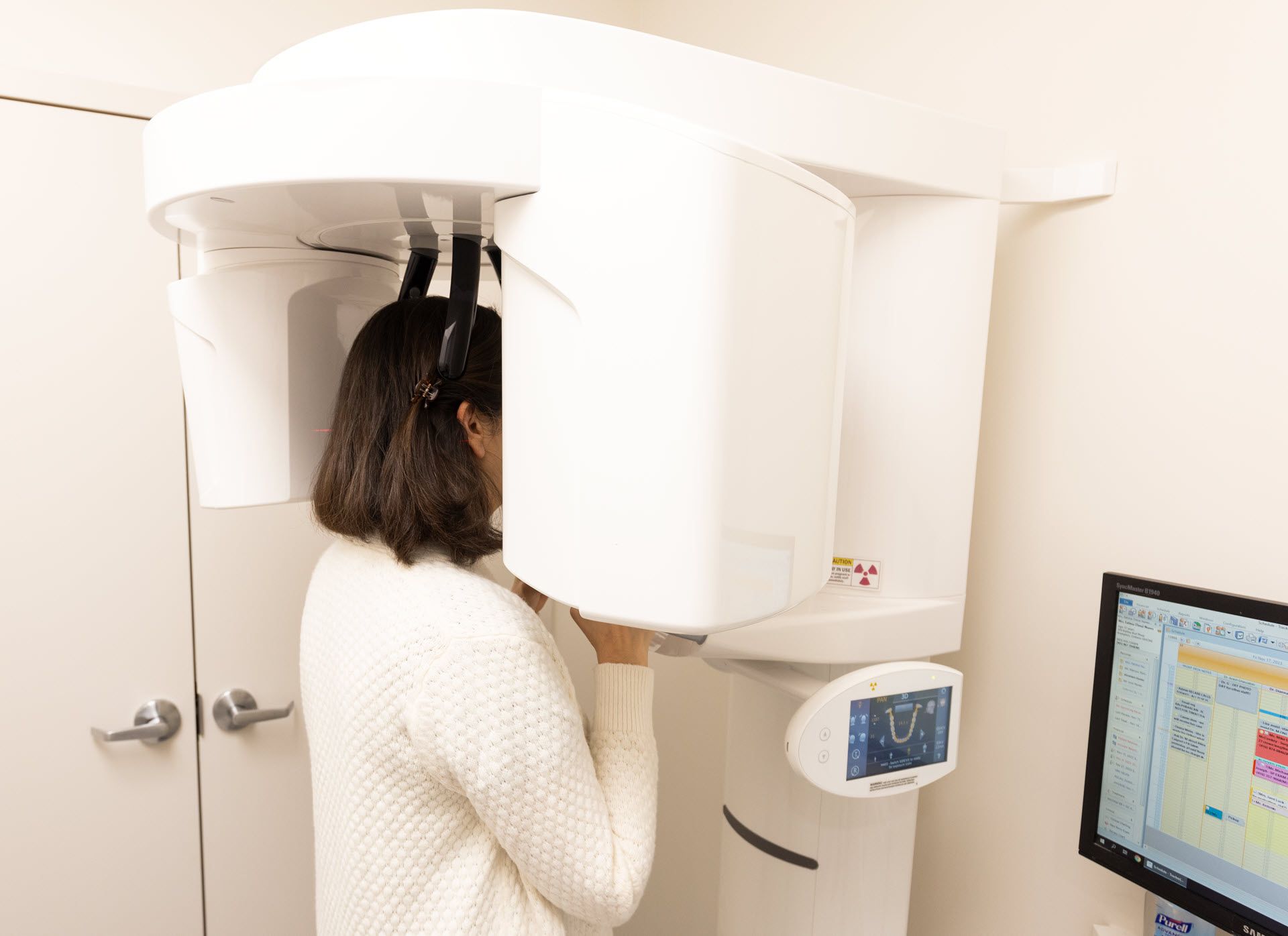CBCT Scan
Cone Beam Computed Tomography (CBCT) scan
Experience the cutting-edge technology of dental cone beam computed tomography (CT) - a revolutionary tool that goes beyond regular x-rays. With just one scan, our state-of-the-art equipment produces stunning 3-D images of your teeth, soft tissues, nerve pathways, and bone. Get a comprehensive view of your dental health like never before, thanks to this groundbreaking technology.
Preparing for this procedure is simple. If there is a chance you might be pregnant, inform your doctor. Dress in loose and comfortable clothing and avoid wearing jewelry. It is possible that you will need to wear a gown.
What Is a CBCT Scan?
Advanced imaging technologies have significantly impacted the field of dentistry by improving the diagnosis and treatment of oral conditions. One notable technology is the Cone Beam Computed Tomography (CBCT) scan, which offers dentists and specialists detailed 3-dimensional images of a patient's oral structures in a non-invasive manner.
CBCT scan Applications
CBCT scans are widely used in dentistry for various purposes, including implant planning, oral surgery, and the evaluation of dental problems like impacted wisdom teeth, TMJ disorders, and root canal complications. The high-definition images produced by CBCT have made it an essential tool for providing customized and efficient dental care.
Before making a decision on whether CBCT Scans are suitable for you, there are some important facts you should be aware of.
Who Needs CBCT Scan?
Reimagine CBCT scans are utilized in modern dentistry to obtain precise images for diagnosing and planning dental treatments. Although they offer numerous advantages, CBCT scans are not always required for every dental patient. Dental professionals recommend CBCT scans based on individual indications.
- Dental Implant Planning: CBCT scans are necessary for patients who are considering dental implants because they provide a thorough view of the jawbone's structure, density, and proximity to vital structures. This information helps dentists determine the best placement for the implant, improving its long-term success and minimizing complications.
- Evaluation of Impacted Teeth: CBCT scans are used to assess impacted teeth, which are teeth that do not emerge correctly through the gum line. Whether it is impacted wisdom teeth or other molars, CBCT scans provide detailed visuals of the tooth's position and orientation, allowing dentists or oral surgeons to plan extractions safely and effectively.
- Diagnosis of TMJ Disorders: Temporomandibular joint (TMJ) disorders can result in discomfort and pain in the jaw joint. CBCT scans are used to assess the structure of the TMJ, detect any abnormalities, and assist in determining suitable treatment approaches.
- Evaluation of Root Canal Complications: CBCT scans are utilized in complex endodontic cases or when standard X-rays do not provide sufficient information. They aid endodontists in diagnosing problems such as root fractures, canal curvature, and persistent infections, resulting in more effective root canal treatments.
- Assessment of Pathologies and Tumors: CBCT scans are used to detect and assess oral pathologies, cysts, and tumors. They help dental professionals visualize these abnormalities' size, location, and extent, allowing for prompt planning of biopsies or referral to specialists for further evaluation.
- Orthodontic Treatment Planning: CBCT scans are used by orthodontists to help them create accurate treatment plans for patients who need orthodontic interventions. These scans provide a 3D visualization of the teeth and jaw relationships, allowing orthodontists to develop personalized treatment approaches, such as braces or Invisalign clear aligners, to achieve the best possible outcomes.
- Evaluation of Trauma: CBCT scans are utilized in cases of dental trauma or facial injuries to evaluate the extent of damage to the teeth, jawbone, and adjacent structures. This aids in formulating treatment strategies for restoring dental function and aesthetics.
CBCT scans offer valuable information but involve a slightly higher radiation dose than traditional dental X-rays. Dentists carefully evaluate the risk-benefit ratio before recommending CBCT scans and ensure that the benefits outweigh the potential risks, particularly for pregnant women and children. If you have additional inquiries about CBCT scans, please reach out to Artin Dental.
What Are The Advantages of CBCT Scan?
The incredible Cone Beam Computed Tomography (CBCT) scan revolutionizes dental diagnostics and treatment planning, unlocking a world of possibilities for dental professionals. Prepare to be amazed by the countless advantages of CBCT scans, as they become an essential tool for dental wizards everywhere. Brace yourself for the magic!
- Precise 3D Imaging: CBCT scans produce high-quality, three-dimensional images of the oral structures, providing a thorough view from various perspectives. This detailed visualization enables dental professionals to accurately evaluate dental anatomy, bone density, and the spatial relationship between teeth, nerves, and other important structures.
- Improved Diagnostic Capabilities: CBCT scans are an effective tool for diagnosing dental issues that may not be visible on traditional 2-dimensional X-rays. They help detect dental abnormalities, pathologies, and structural anomalies at an early stage, leading to more accurate and timely diagnoses.
- Treatment Planning: CBCT scans are utilized in dental practice to aid in treatment planning for a range of procedures, such as dental implants, oral surgeries, and orthodontic treatments. These scans provide dentists with detailed 3D images, allowing for a better understanding of the patient's anatomy and the development of customized treatment plans. This, in turn, enhances treatment accuracy and overall effectiveness.
- Reduced Need for Additional Imaging: CBCT scans are comprehensive and can provide a large amount of information, which often eliminates the need for multiple imaging studies. This means that dental professionals can minimize the use of additional X-rays and reduce patient exposure to radiation.
Addition Benefits of CBCT Scan
- Faster and Non-Invasive: CBCT scans are known for their efficiency, typically requiring only a few seconds to capture the necessary images. Unlike traditional medical CT scans, CBCT scans are non-invasive and do not require contrast dyes or extensive patient preparation.
- Greater Patient Comfort: Patients often report that CBCT scans are more comfortable than traditional CT scans. The scan is of short duration, and patients must stay still during the procedure, which helps reduce any discomfort or anxiety typically associated with it.
- Enhanced Implant Success: CBCT scans are used for dental implant planning as they provide crucial information about bone quality, quantity, and location, which helps ensure accurate implant placement. This plays a significant role in the success and durability of dental implants.
- Orthodontic Applications: CBCT scans are utilized in orthodontics to evaluate tooth and jaw relationships, detect impacted teeth, and facilitate effective treatment planning. They allow orthodontists to develop individualized treatment plans, resulting in enhanced patient outcomes.
- Visualization of Soft Tissues: CBCT scans provide visualization of dental structures as well as surrounding soft tissues, including muscles and nerves. This can be useful for evaluating conditions related TMJ disorders and other soft tissues.
- Enhanced Patient Education: CBCT scans enable effective communication between dental professionals and patients by providing clear, interactive visuals. These 3D images allow patients to better understand their dental conditions, explore potential treatment options, and actively engage in making decisions about their oral health.
CBCT scans have greatly impacted dental imaging and treatment, providing dentists and specialists with the ability to offer more precise and efficient care that is centered around the patient. The benefits of CBCT technology make it a valuable tool in modern dentistry, improving diagnostic accuracy, treatment results, and patient contentment. If you have any additional inquiries regarding CBCT Scans, please feel free to reach out to us.
Book Your Appointment
Book an appointment today with our doctors to discuss Dental Crowns
Artin Dental's CBCT Scan at Downtown Toronto
At Atrin Dental, we offer CBCT scans to help our patients receive the best dental care available. Our Cone Beam Computed Tomography (CBCT) scan is a 3D imaging system that allows us to see inside the teeth and surrounding structures in a precise way. By taking an accurate image of your mouth, we can diagnose and plan treatments more accurately.
If you’re interested in receiving a CBCT scan at our Downtown Toronto location, here are some steps to get you started:
1. Schedule an appointment - Contact us today to book an appointment for your CBCT scan. Please let us know if you have any medical conditions or medications that may affect the scan results.
2. Prepare for the appointment - Before your visit, drink plenty of water and avoid eating food for one hour prior to the appointment so that your stomach does not interfere with the scanning process.
3. Have your scan - During the procedure, you will be asked to hold a bite block between your teeth as part of the scanning process. The entire procedure takes no more than 10 minutes.
4. Get your results - Afterward, our expert team will review and interpret your images and provide you with detailed results about what was found during the scan along with treatment recommendations if needed. We will also discuss other imaging options if necessary, based on individual circumstances.
We look forward to helping you receive optimal dental care with our advanced CBCT Scan technology! Our dental clinic is conveniently located in the PATH of the Exchange Tower and First Canadian Place to serve you with CBCT dental scans. If you have any further inquiries or would like to schedule an appointment, please contact us today!
Frequently Asked Questions
-
What Are The Alternative Treatments of CBCT Scan?
Dental professionals have alternative treatments and imaging options available for patients who may have concerns about radiation exposure or are not suitable candidates for Cone Beam Computed Tomography (CBCT) scans, even though CBCT scans provide a wealth of information for precise diagnosis and treatment planning.
Traditional Dental X-rays: Traditional dental X-rays, also known as 2D radiographs, are commonly used in dentistry for routine dental exams, cavity detection, bone level assessment, and overall oral health evaluation. However, traditional X-rays lack the comprehensive 3D visualization provided by CBCT scans.
Panoramic Radiographs: Panoramic radiographs, also known as panoramic X-rays, offer a comprehensive view of the entire oral cavity, including the upper and lower jaws, teeth, and surrounding structures, all in one image. They are helpful for evaluating dental growth, impacted teeth, and overall dental well-being. While they may not provide the same level of detail as CBCT scans, panoramic radiographs can be suitable in specific situations.
Magnetic Resonance Imaging (MRI): In some instances where CBCT scans are not suitable or when assessing soft tissue is necessary, dental professionals may suggest an MRI. MRIs do not utilize ionizing radiation and are proficient in visualizing soft tissues, such as muscles, ligaments, and nerves in the head and neck area. However, MRIs can be expensive and may not be readily available in all dental practices.
Clinical Examination: In certain dental cases, a comprehensive clinical examination by a dentist or specialist can be enough to make a diagnosis and create a treatment plan. Combining clinical assessments with traditional X-rays can often provide sufficient information to address common dental problems effectively.
If you are thinking about skipping a CBCT scan, talk to your dental provider first. They will take into account your dental issues, medical history, and risk factors to suggest another treatment or imaging choice. The main priorities are patient safety and precise dental care. If you have additional inquiries about CBCT Scans, feel free to contact us.
-
What perils or complexities may arise from the use of a CBCT scan?
Although Cone Beam Computed Tomography (CBCT) scans provide significant advantages in dental diagnostics and treatment planning, it is crucial to acknowledge the potential hazards and factors to consider that come with this advanced imaging technology. Dental experts exercise caution when advising CBCT scans and implement necessary measures to guarantee patient well-being. Allow us to delve into the possible risks and complexities associated with CBCT scans:
Radiation Exposure: CBCT scans employ X-ray technology to create comprehensive 3D visuals of the oral components. Though the radiation dose of a single CBCT scan is typically deemed minimal, it surpasses that of conventional dental X-rays. Continuous or recurring exposure to radiation could potentially endanger pregnant women and young children. Despite the progress made in CBCT technology, radiation doses have significantly decreased, as dentists now take extra precautions by utilizing lead aprons and collars to protect vulnerable regions when conducting scans.
Motion Artifacts: Movement during the CBCT scan can lead to motion artifacts on the images, which could potentially affect their quality and diagnostic accuracy. It is important for patients to maintain stillness during the short scan period in order to obtain clear and dependable images.
Confounding Findings: CBCT scans produce detailed images that may uncover incidental findings unrelated to the original intent of the scan. It is important for dental professionals to interpret these findings carefully to avoid unnecessary follow-ups or treatments.
Financial Considerations: CBCT scans may have a higher cost compared to traditional dental X-rays. It is advisable for patients to have a conversation with their dental provider regarding the procedure's expenses and consider the potential benefits in relation to the financial implications, particularly if insurance does not cover the scan.
Pregnant Women: Dentists prioritize your safety and well-being, especially if you're pregnant or worried about radiation. They'll go the extra mile to choose imaging methods with minimal radiation risks. So don't hesitate to share your medical history and concerns - together, you'll find the perfect imaging approach for you!
Most patients undergo CBCT scans without experiencing any negative effects. Dental professionals are trained to use CBCT technology cautiously, considering the advantages and potential risks based on each patient's individual circumstances. If you have any further inquiries about CBCT Scans, please feel free to reach out to us.
-
What is the Cost of CBCT Scan?
The cost of a CBCT scan varies from $220 to $380 depending on the scan size. You can expect to receive the oral radiologist's report within 10 business days. If you need the results faster, within 2 business days, an additional fee of $50 will be charged. The Ontario Dental Association's Suggested Fee Guide lists the relevant codes for CBCT scans as follows:
Radiographic imaging, comprising Cone Beam Computed Tomography (CBCT) scans, and the process of obtaining these images.
07011 – Limited perspective (such as sextant or a fraction of it, solitary temporomandibular joint): $120
07012 – Expansive perspective (covering 1 arch): $197-234
07013 – Expansive perspective (encompassing 2 arches): $280
X-ray images, Cone Beam Computed Tomography (CBCT), Analysis
07032 – A pair of sessions lasting 30 minutes each will cost $100.
In Ontario, dentists have the option to adhere to or disregard the fee structure provided by the Ontario Dental Association known as the Suggested Fee Guide. It is important to have a discussion with your dentist regarding the fees associated with your treatment prior to proceeding.
Dental insurance plans typically classify CBCT scans as an additional offering, which may or may not be included in your coverage. It is crucial to contact your dental insurance provider beforehand to determine your eligibility, prior to pursuing any dental procedures. To streamline the process, your dentist can assist you in submitting a predetermination form to your dental insurance company.
Patients without dental insurance can take advantage of dental financing options provided by Atrin Dental through Dentalcard. The payment plans offered are affordable, starting at 7.95% and have flexible terms ranging from 6 months to 6 years. If you are interested in learning more about how Dentalcard can help finance your dental treatment, contact us using our contact form.
-
What Are The Steps In The CBCT Scan Procedure?
When you are advised by your dental or radiology professional to undergo a Cone Beam Computed Tomography (CBCT) scan, be prepared for a simple and painless experience. CBCT scans are commonly carried out within specialized offices that possess the necessary CBCT imaging equipment. To provide you with an idea of what to anticipate during the procedure, here are the general steps that are usually followed.
Preparatory Stages and Elucidation: Prior to commencing the scan, the dental personnel will furnish comprehensive guidelines regarding the CBCT procedure. They will attentively cater to any apprehensions you may possess and secure your knowledgeable agreement for the scan.
Ensure no metal objects are present around your head and neck region during the imaging process to prevent any disruption. Be prepared to remove jewelry, glasses, hairpins, hearing aids, or removable dental appliances for the duration of the procedure.
Proper Alignment: You'll receive directed instructions to either perch or recline upon a specific seat or imaging surface according to the particular model of CBCT device employed. The dental expert will responsibly ensure your relaxed arrangement and restricted mobility, effectively minimizing any disturbances in the resulting scan. Accurate images significantly hinge upon achieving the appropriate alignment of your head.
During the scan, it is possible that you will be instructed to clamp your teeth onto a bite block or place your chin onto a chin rest in order to keep your head steady.
The dental team will ensure your safety through the implementation of radiation safety precautions. These precautions are essential for preventing any unnecessary exposure to radiation. In particular, pregnant women and children will receive special protection, such as the use of lead aprons or collars, to shield their sensitive areas from potential harm.
During the scan acquisition process, after ensuring correct positioning, the CBCT machine initiates its activation, initiating the commencement of scan acquisition. By circumnavigating your head, the machine diligently gathers a collection of X-ray images from different viewpoints in order to generate a three-dimensional model of your oral structures. It is of utmost significance to maintain absolute stillness throughout the scan, as any form of movement has the potential to compromise the integrity and precision of the images obtained.
The duration of the scan itself is rather brief, usually lasting from 10 to 40 seconds, varying according to the specific CBCT device and the specific region being scanned.
Following the completion of the scanning process, specific software is utilized to analyze the gathered data. This allows for the creation of intricate 3D visuals showcasing the teeth, jawbone, and neighboring structures. Subsequently, a proficient dental expert, like a dentist or oral radiologist, will meticulously assess and interpret the CBCT images. This in-depth evaluation ensures an accurate diagnosis is made, enabling the development of a personalized treatment strategy if deemed necessary.
During a subsequent appointment, your dentist will engage in a follow-up consultation to delve into the findings derived from the CBCT scan with you. Moreover, they will take the time to elucidate any dental problems that have been detected and propose suitable courses of treatment in accordance with the outcomes.
Prior to undergoing a CBCT scan, it is crucial to maintain an open line of communication with your dentist. This encompasses discussing pertinent medical background, allergies, and any concerns you may have. By following adequate preparation and safety standards, the CBCT scan offers valuable information that assists in providing tailored and efficient dental treatment, ultimately leading to enhanced oral health. If you require additional information regarding CBCT Scans, kindly reach out to us.
-
Is it possible for me to undergo a CBCT scan while pregnant?
During pregnancy, it is crucial to approach medical procedures and diagnostic tests with great care. The usage of ionizing radiation in Cone Beam Computed Tomography (CBCT) scans raises apprehensions about the possible dangers it may pose to the fetus's development. Consequently, it is important to meticulously assess and discuss with your dentist and obstetrician whether or not undergoing a CBCT scan is the right choice for you. Here are a few vital factors that should be taken into consideration:
Reducing Radiation Exposure: When it comes to CBCT scans, where X-rays are utilized, there is a potential threat to the growing fetus, especially in the initial stages of pregnancy when vital organs are being formed. To err on the side of caution, medical professionals ordinarily opt to refrain from employing ionizing radiation, such as CBCT scans, during pregnancy.
Delaying Non-Urgent Scans: CBCT scans are typically rescheduled for a later time, specifically postpartum, in dental cases that are not urgent. This measure is taken to prioritize the well-being of the unborn baby. If the dental concern is not pressing, it is recommended to wait until after pregnancy before proceeding with the scan.
When a CBCT scan is required during pregnancy, dental practitioners will prioritize radiation shielding by implementing protective measures to minimize exposure of the abdomen and the developing fetus. This can involve utilizing lead aprons and thyroid collars to effectively safeguard sensitive regions and restrict any potential radiation exposure.
Consider alternative imaging methods that do not use ionizing radiation, such as ultrasound or Magnetic Resonance Imaging (MRI), whenever possible. These techniques utilize non-ionizing radiation and are generally deemed safe for pregnant women.
Making an educated choice: When considering a CBCT scan while pregnant, it is vital for the patient, dentist, and obstetrician to engage in a comprehensive dialogue. It is crucial to meticulously assess the advantages and potential risks associated with the procedure in order to arrive at a well-informed decision that prioritizes the wellbeing and security of both the expectant mother and the developing baby.
Prompt Disclosure: Should you suspect or detect a pregnancy while having a scheduled CBCT scan, it is of utmost importance to promptly notify your dental practitioner. Swiftly disclosing this information will enable the dental staff to reassess the relevance of the scan and undertake any vital modifications to your treatment course.
It is crucial to prioritize the overall health and welfare of both the pregnant woman and the growing fetus. Collaboration between dental practitioners and obstetricians is essential in order to ensure secure and suitable care throughout pregnancy. Should there be any doubts or worries regarding the safety of a CBCT scan while pregnant, feel free to reach out to us without hesitation.
-
How should I prepare for CBCT scan?
No specific arrangements are needed before undergoing a cone beam CT exam.
Before the exam, it's important to prepare by eliminating anything that could disrupt the imaging process. Make sure to get rid of any metallic items, like jewelry, glasses, hairpins, and hearing aids. However, don't forget to bring along any removable dental work to the exam. Your dentist or oral surgeon might want to take a look at them too.
It is crucial for women to ensure that they notify their dentist or oral surgeon if they suspect they may be pregnant. For additional details concerning pregnancy and x-rays, please refer to the Safety page.
-
What does the CBCT scan equipment look like?
Cone beam CT scanners come in two forms: those with an upright chair for seating and those with a versatile table for patients to lie on during the examination. In machines equipped with a chair, there is a rotating C-arm—a device housing an x-ray source and detector designed to enhance x-ray images. Conversely, cone beam CT machines featuring a table are equipped with a rotating gantry for image acquisition purposes.
-
How does the CBCT scan procedure work?
Throughout a cone beam CT scan, a comprehensive 360-degree rotation is executed by the C-arm or gantry encircling the cranium. This rotation captures numerous images at varying angles, which are subsequently reconstructed to forge a sole 3-Dimensional image.
The C-arm or gantry revolves, with the x-ray source and detector mounted at opposite ends, and they rotate together. Within one rotation, the detector can produce a range of 150 to 200 high-definition 2-D images. These images are digitally merged to create a 3-D image, offering important insights into your oral and craniofacial well-being to your dentist or oral surgeon.
-
How is the CBCT scan procedure performed?
In accordance with the specific type of cone beam CT scanner employed, your presence in the examination seat or reclining on the examination table will be requested. Your dentist or oral surgeon shall accurately position you in a manner that ensures the area of concern is perfectly aligned within the beam. While the x-ray source and detector encircle you for a complete 360-degree rotation or possibly less, you will be instructed to maintain utmost stillness.
For a comprehensive assessment of the entire oral cavity and dental structures, commonly known as a full mouth x-ray, the process generally lasts from 20 to 40 seconds. On the other hand, a targeted examination of a selected region within the maxilla or mandible, referred to as a regional scan, typically requires less than 10 seconds.
-
What will I experience during and after the CBCT scan procedure?
You can undertake a cone beam CT exam without encountering any discomfort. Upon finishing the examination, you can promptly resume your everyday activities.
-
Who interprets the CBCT scan results and how do I get them?
Your images will be examined by a professional, such as a dentist, oral surgeon, or radiologist. They can either personally talk to you about the findings or relay them to your referring dentist or physician.
-
What are the benefits vs. risks of CBCT scan?
Benefits
Improved image quality is achieved through the reduction of scatter radiation, primarily attributed to the concentrated x-ray beam.
Examining a single scan reveals a myriad of perspectives and angles that can be altered to offer a comprehensive assessment.
Cone beam computed tomography (CT) scans offer a broader range of data than traditional dental x-rays, enabling more accurate strategizing for treatment.
CT scans are characterized by their painlessness, non-intrusiveness, and high level of precision.
CT is a highly advantageous imaging technique that possesses the remarkable capability to capture images of bone and soft tissue simultaneously.
After undergoing a CT scan, there is no trace of radiation left within the patient's body.
CT scanning relies on x-rays that are designed to have no immediate adverse effects.
Risks
Excessive exposure to radiation carries a small but ever-present potential for cancer. Nonetheless, the advantages of precise diagnosis significantly surpass the associated peril implicated in undergoing a CT scan.
Due to children's heightened sensitivity towards radiation, it is imperative to limit their exposure to CT exams exclusively for crucial diagnostic purposes. The repetition of these exams should strictly be avoided unless it is absolutely necessary. It is always advisable to conduct CT scans using low-dose techniques when dealing with children.
Navigation
Services
Business Hours
- Mon, Wed, Thu
- -
- Tuesday
- -
- Friday
- -
- Sat - Sun
- Closed
All Rights Reserved | Artin Dental Office
Website & Marketing by nerDigital.com

